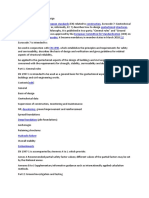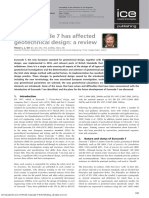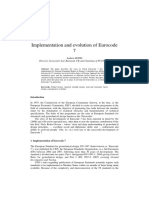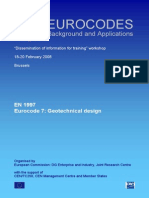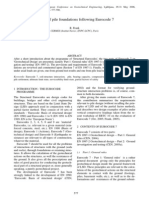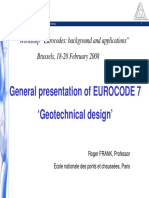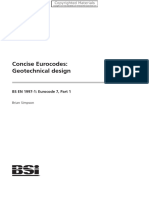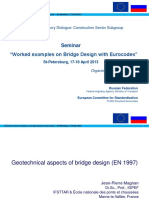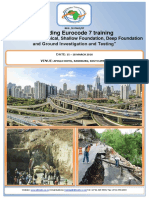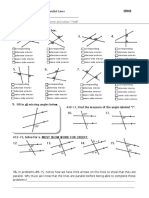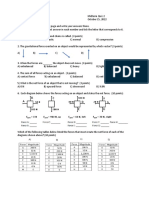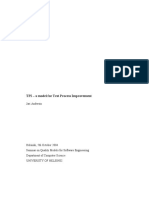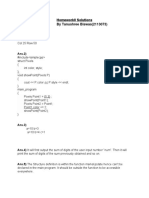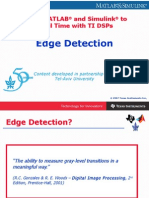GEOTECHNICS 313174
Session topic
Eurocode 7: Geotechnical Design
Session objectives
To take a look at the most significant aspects of Eurocode 7.
Intended audience
Civil, structural and geotechnical engineers, and construction professionals working with
them.
Summary
Programme
Eurocode 7 is Europe’s first geotechnical design code to share a common philosophy
with the design methodology for structures.
It is divided into two parts, the first covering General Rules and the second Ground
Investigation and Testing.
Part 1 is subdivided into twelve sections and nine annexes and provides a general
framework for geotechnical design, definition of ground parameters, characteristic and
design values, general rules for site investigation and rules for the design of the main
types of geotechnical structures.
Part 2 is subdivided into six sections and twenty-four annexes and provides detailed rules
for site investigations, general test specifications, derivations of ground properties and
the geotechnical model of the site.
This programme picks out some of the most significant aspects of Eurocode 7.
Programme notes
These notes are kindly provided by the contributors and are reproduced with kind
permission.
1 GEO 313174
� Study notes
About the contributors
Andy Harris is Director of Geomantix Ltd and has over 30 years’ experience in
geotechnical consultancy both with major consulting firms and as an independent
consultant. He is a co-author of the BSI Guide to Structural Eurocodes for students of
structural design and Decoding Eurocode 7.
Andrew Bond is Chairman of the Eurocode 7 commitee TC250/SC7, co-author of the
book Decoding Eurocode 7 (with Andrew Harris), and architect/ developer of the design
programs ReWaRD, Repute, and Redoubt. He has over 30 years’ experience in
foundation design.
Discussion Points
• Describe the major change in philosophy behind Eurocode 7.
• Explain what is meant by the concept of limit state design.
• Outline how Eurocode 7 helps to classify risk.
• Discuss the concepts of ultimate and serviceability limit states.
• Evaluate how the requirements for supervision, monitoring and testing are covered in
Eurocode 7.
2 GEO 313174
� Study notes
GEOTECHNICS 313174
Notes
Eurocode 7: Geotechnical Design
Andrew Harris, Director and Dr Andrew Bond, Director, Geomantix Ltd
Eurocode 7 – Overview
Eurocode 7 covers geotechnical design and is provided in two parts: Part 1 – General
rules (BS EN1997-1) and Part 2 – Ground investigation and testing (BS EN1997-2).
Part 1 is divided into twelve sections and nine annexes, as shown in Figure 1. In this
diagram, the size of each segment of the pie is proportional to the number of paragraphs
in the relevant section.
Figure 1 Contents of Eurocode 7 Part 1(Bond and Harris 2008)
Part 1 provides a general framework for geotechnical design; definition of ground
parameters; characteristic and design values; general rules for site investigation; rules
for the design of the main types of geotechnical structures; and some assumptions on
execution procedures.
Part 2 is divided into six sections and twenty-four annexes, as illustrated in Figure 2
3 GEO 313174
� Study notes
Figure 2 Contents of Eurocode 7 Part 2 (Bond and Harris 2008)
Part 2 provides detailed rules for site investigations, general test specifications,
derivations of ground properties and the geotechnical model of the site, and examples of
calculation methods based on field and laboratory testing.
Eurocode 7 Part 1 General Rules
The table below shows both the common (white background) and different (grey) sub-
section headings in Sections 6–9 and 11–12 of EN 1997-1, dealing with the rules for
geotechnical structures, each present the information in a different manner reflecting the
authorship of these sections. This difference in authorship has led to inconsistencies in
the sub-section headings for each geotechnical structure and to the associated level of
detail. For example, §6.5 for spread foundations provides a relatively short section on
ultimate limit state design with no illustrations, whereas this topic is covered in detail in
§9.7 for retaining structures with a large number of diagrams.
Sub- Common to §6 Spread §8 §7 Pile §9 Retaining
section §6-9 and §11 foundations Anchorages foundations structures
and §12
§x.1 General
§x.2 Limit states
§x.3 Actions, geometrical data, and design situations (or variations on this title)
§x.4 Design methods and construction considerations (or variations on this title)
§x.5 Ultimate limit state design Pile load tests Determination
of earth
pressures
§x.6 Serviceability limit state design Axially loaded Water
piles pressures
§x.7 Supervision Foundations Suitability Transversely Ultimate limit
and on rock; tests loaded piles state design
Monitoring additional
design
considerations
4 GEO 313174
� Study notes
§x.8 - Structural Acceptance Structural Serviceability
design of tests design of piles limit state
spread design
foundations
§x.9 - Supervision and monitoring (or variations on (missing)
this title)
Design requirements
Perhaps the most significant requirement of Eurocode 7 is the following commitment to
limit state design:
For each geotechnical design situation it shall be verified that no relevant limit state ...
is exceeded. [EN 1997-1 §2.1(1)P]
For many geotechnical engineers across Europe, this represents a major change in
design philosophy. Traditional geotechnical design, using lumped factors of safety, has
proved satisfactory over many decades and much experience has been built on such
methods. However, the use of a single factor to account for all uncertainties in the
analysis – although convenient – does not provide a proper control of different levels of
uncertainty in various parts of the calculation. A limit state approach forces designers to
think more rigorously about possible modes of failure and those parts of the calculation
process where there is most uncertainty. This should lead to more rational levels of
reliability for the whole structure. The partial factors in Eurocode 7 have been chosen to
give similar designs to those obtained using lumped factors – thereby ensuring that the
wealth of previous experience is not lost by the introduction of a radically different
design methodology.
Limit state philosophy has been used for many years in the design of structures made of
steel, concrete, and timber. Where these structures met the ground was, in the past, a
source of analytical difficulties. The Eurocodes present a unified approach to all
structural materials and should lead to less confusion and fewer errors when considering
soil-structure interaction.
Complexity of design
A welcome requirement of Eurocode 7 is the mandatory assessment of risk for all
design situations:
... the complexity of each geotechnical design shall be identified together with the
associated risks ... a distinction shall be made between light and simple structures
and small earthworks ... with negligible risk [and] other geotechnical structures.
[EN 1997-1 §2.1(8)P]
The idea here is that when negligible risk is involved, the design may be based on past
experience and qualitative geotechnical investigations. In all other cases, quantitative
investigations are required. There are many schemes for assessing risk that may be used
in conjunction with a Eurocode 7 design. For example, the approach outlined in the UK
Highways Agency’s document HD22/023 requires designers to identify possible
hazards for a project or operation within that project. Such risk assessments clearly
5 GEO 313174
� Study notes
satisfy the requirements of Eurocode 7 to identify the complexity and risks of
geotechnical design.
Geotechnical categories
To assist geotechnical engineers in classifying risk, Eurocode 7 introduces three
Geotechnical Categories, their design requirements, and the design procedure they
imply — as summarized in the table below. The Geotechnical Categories are defined in
a series of Application Rules, not Principles, and hence alternative methods of assessing
geotechnical risk could be used.
The design requirements and procedure for GC3 warrant comment, since it is not
immediately clear what ‘include alternative provisions and rules’ means. Eurocode 7
does not say ‘use alternative Principles and rules’ (even though the word ‘provisions’
could be taken to include the Principles). It is considered that designs for GC3
structures should follow the Principles of Eurocode 7, but the Application Rules
provided in the standard may not be sufficient on their own to satisfy those Principles.
Hence alternative (and/or additional) rules may be required.
It is not necessary to classify all parts of a project in one Geotechnical Category.
Indeed, many projects will comprise a mixture of GC1 and GC2 (and in some cases
GC3) elements.
Eurocode 7 gives examples of structures in the three Geotechnical Categories, as shown
in the table below. A structure’s Geotechnical Category influences the level of
supervision and monitoring called for in Section 4 of EN 1997-1.
GC Includes ... Design requirements Design procedure
1 Small and relatively Negligible risk of instability or Routine design
simple structures ... with ground movements; ground and construction
negligible risk conditions are ‘straightforward’; (i.e. execution)
no excavation below water table methods
(or such excavation is
‘straightforward’)
No examples given in EN 1997-1.
Investigation requirements: Normally limited (local knowledge and experience often
sufficient)
2 Conventional types of Quantitative geotechnical data Routine field and
structure and foundation and analysis to ensure lab testing Routine
with no exceptional risk fundamental requirements are design and
or difficult soil or satisfied execution
loading conditions
Examples: spread, raft, and pile foundations; walls and other structures retaining or
supporting soil or water; excavations; bridge piers and abutments; embankments and
earthworks; ground anchors and other tie-back systems; tunnels in hard, non-fractured
rock, not subject to special water-tightness or other requirements.
Investigation requirements: Provisions of EN 1997-2 apply
6 GEO 313174
� Study notes
3 Structures or parts of Include alternative provisions and rules to those in
structures not covered Eurocode 7
above
Examples: very large or unusual structures; structures involving abnormal risks or
unusual or exceptionally difficult ground or loading conditions; structures in highly
seismic areas; structures in areas of probable site instability or persistent ground
movements that require separate investigation or special measures
Investigation requirements: Amount of investigations at least the same as for Category
2 projects. The circumstances that place a project in Category 3 may necessitate
additional investigations and more advanced tests
Structures in GC1 can safely be designed and built based on past experience, because
they involve no unusual features or circumstances. The examples in GC2 form the
bread and butter work of many geotechnical design offices, requiring thoughtful but not
unusual design and construction. However, the design of structures in GC3 requires
careful thought because of their exceptional nature; the keywords are ‘large or unusual’,
‘abnormal or exceptionally difficult’, ‘highly seismic’, ‘probable instability’, etc.
Limit states
When designing a geotechnical structure, the engineer needs to identify the possible
ultimate and serviceability limit states that are likely to affect the structure. Ultimate
limit states are those that will lead to failure of the ground or the structure;
serviceability limit states are those that result in unacceptable levels of deformation,
vibration, noise, or flow of water or contaminants.
Eurocode 7 identifies five categories of ultimate limit states for which different sets of
partial factors are provided: failure or excessive deformation in the ground (GEO);
internal failure or excessive deformation of the structure (STR); loss of static
equilibrium (EQU); loss of equilibrium or excessive deformation due to uplift (UPL);
hydraulic heave, piping, and erosion (HYD).
The following ultimate limit states should be checked for all geotechnical structures:
loss of overall stability (of the ground and/or associated structures); combined failure in
the ground and structure; and structural failure due to excessive ground movement. For
serviceability limit states the following should be checked: excessive settlement;
excessive heave; and unacceptable vibrations.
Verification of the serviceability limit state is a key requirement of a Eurocode 7 design,
which does not explicitly feature in more traditional approaches. In traditional design it
is assumed in many calculation procedures that the lumped factor of safety provides not
only safety against failure but also will limit deformations to tolerable levels. For
example it is common to adopt factors of safety against bearing failure of shallow
foundations in excess of 3.0. This is far greater than needed to ensure sufficient reserve
against failure. Eurocode 7 generally requires a specific check that serviceability limits
are met and thus serviceability requirements are more likely to be the governing factor
for many settlement sensitive projects.
7 GEO 313174
� Study notes
Design situations
Design situations have a key role to play in the selection of actions to include in design
calculations and in the choice of partial factors to apply to both actions and material
properties. Design situations are:
Sets of physical conditions representing the real conditions occurring during a certain
time interval for which the design will demonstrate that relevant limit states are not
exceeded. [EN 1990 §1.5.2.2]
Eurocode 7 requires consideration of both short- and long-term design situations, to
reflect the sometimes vastly different resistances obtained from drained and undrained
soils. At first sight, the requirements of EN 1997-1 appear to cut across those of EN
1990. However, it is not difficult to combine these ideas to cater for common
geotechnical problems:
Design Real Term Example
situation conditions
Persistent Normal Long Buildings and bridges founded on coarse soils
and fully-drained fine soils
Short Partially-drained slope in fine soils (with DWL
less than 25 years)
Transient Temporary Long Temporary works in coarse soils
Short Temporary works in fine soils
Accidental Exceptional Long Buildings and bridges founded on coarse soils
and quick-draining fine soils
Seismic Short Buildings and bridges founded on slow-
draining fine soils
Geotechnical actions
EN 1997-1 lists twenty different types of action that should be included in geotechnical
design. These include obvious things, such as the weight of soil, rock, and water; earth
pressures and ground-water pressures; and removal of load or excavation of ground —
and less obvious things, such as movements caused by caving; swelling and shrinkage
caused by climate change; and temperature effects, including frost action.
Distinction between favourable and unfavourable actions
The Eurocodes make an important distinction between favourable (or stabilizing) and
unfavourable (destabilizing) actions, which is reflected in the values of the partial
factors γF applied to each type of action. Unfavourable/destabilizing actions are
typically increased by the partial factor (i.e. γF > 1) and stabilizing actions are decreased
or left unchanged (i.e. γF ≤1).
Consider the design of the T-shaped gravity retaining wall shown in Figure 3. To
provide sufficient reliability against bearing capacity failure, the self-weight of the wall
and the soil on top of its heel (W) should be treated as unfavourable (since they increase
the effective stress beneath the wall base) — but as favourable for sliding and
8 GEO 313174
� Study notes
overturning. The imposed surcharge q is unfavourable for bearing, sliding, and
overturning where it acts to the right of the virtual plane shown in Figure 3. But where
it extends to the left of the virtual plane, it has the same effect as the wall’s self-weight W.
Figure 3 Examples of favourable and unfavourable actions (Bond and Harris 2008)
Consider next the vertical and horizontal thrusts Uv and Uh owing to ground water
pressure acting on the wall’s boundaries. The horizontal thrust Uh is unfavourable for
bearing, sliding, and overturning; whereas the vertical thrust Uv is favourable for
bearing (since it helps to counteract W), but unfavourable for sliding (reducing the
effective stress beneath the wall base) and overturning (since it increases the
anticlockwise overturning moment about ‘O’).
But it is illogical to treat an action as both favourable and unfavourable in the same
calculation. Eurocode 7 deals with this issue in what has become known as the ‘Single-
Source Principle’:
Unfavourable (or destabilising) and favourable (or stabilising) permanent actions may
in some situations be considered as coming from a single source. If ... so, a single
partial factor may be applied to the sum of these actions or to the sum of their effects.
[EN 1997-1 §2.4.2(9)P NOTE]
This note allows the thrusts Uh and Uv to be treated in the same way – either both
unfavourable or both favourable, whichever gives the more onerous design condition.
The Single-Source Principle has a profound effect on the outcome of some very
common design situations. It also precludes the use of submerged weights in design
calculations since, by replacing the gross weight W and water thrust Uv in Figure 3 by
the submerged weight W’ = W – Uv, the choice is implicitly made to treat both the self-
weight and the water thrust in the same way..
Geotechnical design
Driscoll et al (2007) state that ‘The Eurocodes adopt, for all civil and building
engineering materials and structures, a common design philosophy based on the use of
9 GEO 313174
� Study notes
separate limit states and partial factors, rather than ‘global’ factors (of safety); this is a
substantial departure from much traditional geotechnical design practice ... an
advantage of BS EN 1997-1 is that its design methodology is largely identical with that
for all of the structural Eurocodes, making the integration of geotechnical design with
structural design more rational.’
The basic requirements of design are that for ultimate limit states the design effect of
the actions, Ed, must less than or equal to the design resistance, Rd
Ed ≤ Rd
And for serviceability limit states that the design effect of the actions, Ed, must be less
than or equal to the limiting design value of the relevant serviceability criterion, Cd
Ed ≤ Cd
Geotechnical design differs from design in other structural materials in that both the
design actions and the design resistances are functions of the actions, material
properties and dimensions of the problem. For example when assessing sliding in a
retaining wall design the horizontal forces due to the earth (design effect of the actions)
are derived from the material properties of the soil and the dimensions of the problem,
similarly the resistance to sliding (design resistance) is also derived from the actions,
material properties and the dimensions. Thus, in this regard, geotechnical calculations
have a greater level of complexity than design in other structural materials where
actions are not normally a function of the material properties and resistances not a
function of the actions.
Limit states should be verified by calculation; prescriptive measures; experimental
models and load tests; an observational method; or a combination of these approaches.
Design by calculation involves a number of elements. These include three basic
variables: actions (e.g. the weight of soil and rock, earth and water pressures, traffic
loads, etc.), material properties (e.g. the density and strength of soils, rocks, and other
materials), and geometrical data (e.g. foundation dimensions, excavation depths,
eccentricity of loading, etc.).
The basic variables are entered into calculation models, which may include
simplifications but are required to ‘err on the side of safety’. These models may be
analytical (e.g. bearing capacity theory), semi-empirical (e.g. the alpha method of pile
design), or numerical (e.g. finite element analysis).
10 GEO 313174
� Study notes
Figure 4 Overview of verification of strength (Bond and Harris 2008)
Figure 4 indicates where the partial factors used in design by calculation may be
applied. Two “sets” of partial factors γF (A1 and A2) are provided for actions, two sets
of partial factors γM (M1 and M2) for material properties, and four sets of partial
factors γR (R1, R2, R3 andR4) are provided for resistances.
Eurocode 7 presents three different design approaches for carrying out ultimate limit
state analysis for the GEO and STR limit states. These approaches apply the partial
factor sets in different combinations in order to provide reliability in the design. The
method of applying the partial factors reflects the differing opinions regarding
geotechnical design held across the European Union. In essence, Design Approach 1
provides reliability by applying different partial factor sets to two variables in two
separate calculations (‘Combinations’ 1 and 2); whereas Design Approaches 2 and 3
apply factor sets to two variables simultaneously, in a single calculation as outlined in
the table below.
In the UK, Design Approach 1 is being adopted requiring two calculations to be carried
out: Combination 1 where actions are factored and material properties are left
unchanged and Combination 2 where material properties are factored and only variable
unfavourable actions are factored.
11 GEO 313174
� Study notes
Structure Main variable that gets factored in Design Approach
1 2 3
Combination 1 Combination 2
General Actions Material Actions (or Structural actions
properties effects) and (or effects) and
resistances material properties
Slopes Effects of actions Structural effects of
and resistances actions and
material properties
Piles and Resistances Actions (or Structural actions
anchorages effects) and 9or effects) and
resistances material properties
For example consider a simple rectangular footing of length 2.5m, breadth 1.5m and
thickness 0.5m which is founded at a depth of 0.5m in dry sand. The sand has a weight
density of 18kN/m3 with a characteristic angle of friction, φ’k, of 35o and the footing is
subject to a permanent vertical action of 800kN and variable action of 450kN.
For Combination 1 the permanent actions are increased by the partial factor, γG = 1.35
and the variable actions are increased by the partial factor, γQ = 1.5. Thus the design
vertical action is the weight of the footing plus the loads acting on it multiplied by the
relevant partial factor giving a design effect of the actions, Ed = 1818.3kN. The design
resistances are calculated from the design angle of friction, for Combination 1, using
partial factor, γφ = 1.0 therefore φ’d = 35o. Using standard bearing capacity theory as
given in Appendix D of EN 1997-1 gives a design resistance, Rd = 3388.1kN, thus, for
Combination 1, Rd >> Ed.
For Combination 2 the permanent actions are increased by the partial factor, γG = 1.0
and the variable actions are increased by the partial factor, γQ = 1.3. Thus the design
vertical action is the weight of the footing plus the loads acting on it multiplied by the
relevant partial factor giving a design effect of the actions, Ed = 1431.9kN. The design
resistances are calculated from the design angle of friction, for Combination 2, using
partial factor, γφ = 1.25 therefore φ’d = 29.3o. Using standard bearing capacity theory as
given in Appendix D of EN 1997-1 gives a design resistance, Rd = 1479kN. Thus for
Combination 2, Rd is only marginally greater than Ed and Combination 2 governs the
geotechnical design. For a full discussion of this example and similar problems refer to
Bond and Harris (2008).
‘Prescriptive measures’ are a combination of conservative design rules and strict control
of execution that, if adopted, avoid the occurrence of limit states. The design rules,
which often follow local convention, are commonly set by local or national authorities,
via building regulations, government design manuals, and other such documents. These
design rules may be given in a country’s national annex to EN 1997-1. Design by
prescriptive measures may be more appropriate than design by calculation, especially
when there is ‘comparable experience’, i.e. documented (or other clearly established
information) in similar ground conditions, involving similar structures – suggesting
similar geotechnical behaviour.
12 GEO 313174
� Study notes
Eurocode 7 acknowledges the role of large- and small-scale model tests in justifying the
design of geotechnical structures by calculation, prescriptive measures, or observation.
However, apart from requiring time and scale effects to be considered and differences
between the test and real construction to be allowed for, EN 1997-1 provides very little
guidance on design by testing.
In a similar way to design by testing, Eurocode 7 acknowledges the role of the
Observational Method in the design and construction of geotechnical structures, but
provides little guidance on how to implement it. Certain actions must be taken: establish
limits of behaviour, assess the range of possible behaviour, devise a plan of monitoring,
devise a contingency plan, and adopt it if behaviour goes outside acceptable limits.
Supervision, monitoring, and maintenance
Eurocode 7 has specific requirements to ensure the quality and safety of a structure
including: supervision of the construction process and workmanship, monitoring the
performance of the structure, checking ground conditions, checking construction, and
maintenance. EN 1997-1 qualifies this requirement by saying these tasks should be
undertaken ‘as appropriate’. Thus, if construction does not need supervising, or the
structure does not need monitoring or maintaining, then the design could explicitly rule
out the need for them.
Supervision involves checking design assumptions are valid, identifying differences
between actual and assumed ground conditions, and checking construction is carried out
according to the design. A plan of supervision should be prepared, stating acceptable
limits for any results obtained, and indicating the type, quality, and frequency of
supervision. The amount and degree of inspection and control and the checking of
ground conditions and construction all depend on the Geotechnical Category (GC) in
which the structure is placed. The fact that EN 1997-1 relates its requirements for
supervision to the Geotechnical Categories may make their adoption difficult to avoid.
Monitoring involves measurements of ground deformations, actions, contact pressures,
and such like and an evaluation of the performance of the structure. For structures
placed in Geotechnical Category 1, such evaluation is simple, qualitative and based
largely on inspection. For Category 2 structures, the movement of selected points on the
structure should be measured. Finally, for Category 3 structures, monitoring also
involves analysis of the construction sequence.
If an alternative method of assessing geotechnical risk is used, then the amount of
inspection, monitoring and control should be selected appropriately for the risk
involved.
Maintenance of a structure ensures its safety and serviceability and the requirements for
it should be specified to the owner or client. These requirements include identifying
those parts of the structure that require regular inspection, warning about work that
should not be undertaken without prior design review, and indicating the frequency of
inspection.
13 GEO 313174
� Study notes
Although EN 1997-1 imposes specific requirements for supervision, monitoring, and
maintenance, it gives few practical recommendations as to the actions that need to be
taken to meet those requirements. This is demonstrated by the small number of
paragraphs on this subject in the whole of Part 1 (thirty-three), broken down as follows:
§5 Fill, dewatering, etc., eight paragraphs; §6 Spread foundations, two; §7 Pile
foundations, eight; §8 Anchorages, eight; §9 Retaining structures, none; §11 Overall
stability, two; and §12 Embankments, five.
Eurocode 7 Part 2 Ground investigation and testing
The values provided in any partial factor system are swamped by the potential
variability in geotechnical parameters both laterally and with depth. It is thus critical to
any design that suitably conservative models are selected on the basis of the information
available. EN 1997-2 provides detailed guidance on how to derive geotechnical
parameters both directly from field tests and from laboratory work. It also emphasises
the importance of adequate site investigation providing guidance on the minimum
requirements for the numbers and depths of investigation points as well as the
associated testing.
Further, it details the reporting requirements for a design to be compliant with Eurocode
7 which encapsulate much of what is current good practice but seeks to bring greater
coordination between the structural and geotechnical engineer. This is accomplished
through a series of reports culminating in the Geotechnical Design Report as
summarised in Figure 5.
Figure 5 Summary of geotechnical reporting to Eurocode 7 (Bond and Harris 2008)
The Geotechnical Design Report is a key feature of a Eurocode 7 design, bringing
together all the factual data and interpretation leading to the selection of an appropriate
ground model and characteristic parameters as shown in Figure 6. The presentation of
a traditional interpretative report by a site investigation contractor may no longer be
appropriate as Eurocode 7 requires differing characteristic parameters for different limit
state calculations. In addition the design is crucially dependent on a knowledge of the
permanent and variable actions which are often unknown at the investigation stage.
14 GEO 313174
� Study notes
Figure 6 Contents of the Geotechnical Design Report (Bond and Harris 2008)
EN 1997-2 itself does not contain all the detail necessary to perform in situ and
laboratory tests so it refers extensively to a new suite of international and European
standards, prepared jointly by ISO technical committee TC 182 and CEN TC 341, as
summarized in Figure 7.
Figure 7 Complementary geotechnical investigation and testing standards (Bond and
Harris 2008)
15 GEO 313174
� Study notes
Each of the standards within each group is divided into a number of parts, as shown in
the outer ring of Figure 5. The entire suite comprises nearly fifty standards or
specifications.
It also does not contain information on how to carry out geotechnical processes and
refers to a further series of standards covering execution as summarised in Figure 8
below.
Figure 8 Overview of the geotechnical execution standards (Bond and Harris 2008)
Concluding remarks
The introduction of the Eurocodes will challenge current design processes and introduce
greater rigour into geotechnical design. However, there will be considerable concern
that experience built up over many years will be lost or difficult to apply in this new
regime.
EN 1997 Parts 1 and 2 are relatively short documents and do not contain the detailed
guidance found in such current British Standards as BS 5930, 8002 and 8004 or other
related publications such as CIRIA C580. However, the new codes refer out to a large
number of other documents that will provide the detail. Further work is currently
underway to modify the existing British Standards so that they do not conflict with the
Eurocodes ensuring that they can continue to be used.
As experience is gained in using the codes it is hoped that a unified approach to GEO
and STR may be developed avoiding the complications of different design approaches
and enabling greater transparency across the European Union. Further it is likely that
the partial factors themselves will be modified to ensure economical design.
Bond, A. J. and Harris, A. J. (2008), Decoding Eurocode 7, Taylor and Francis
Driscoll, R., Powell, J., and Scott, P. (2007), A designers’ simple guide to BS EN 1997,
London: Dept for Communities and Local Government
16 GEO 313174


